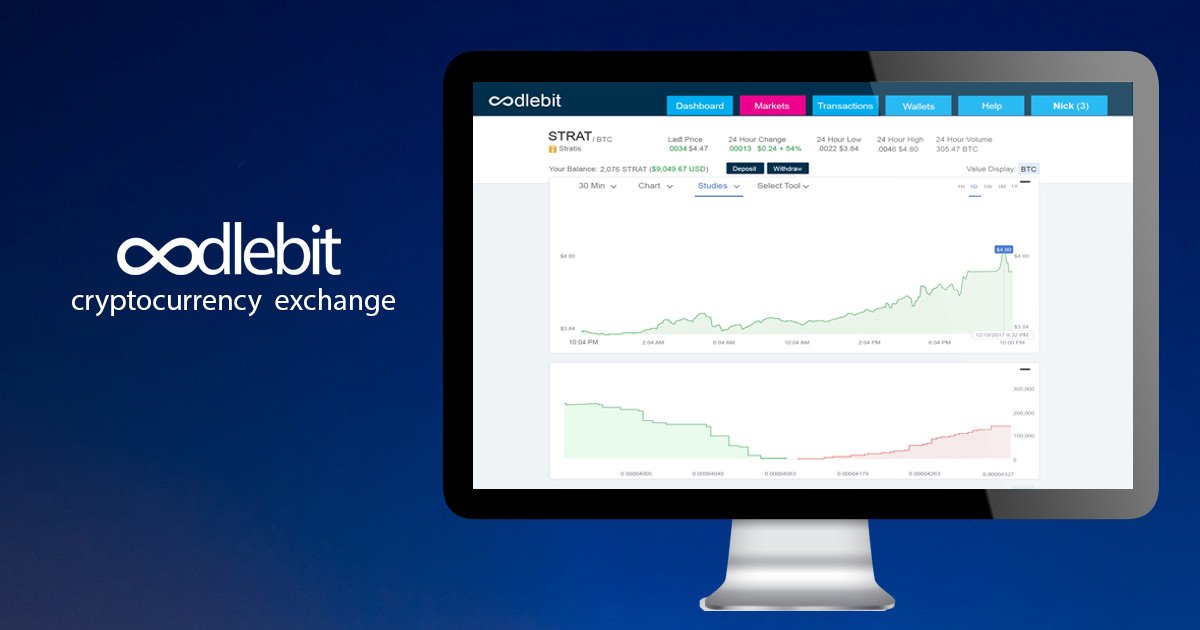Oodlebit Exchange{US Based Trading Platform} (OODL)

cryptocurrency exchanges are websites where you can buy, sell, or exchange cryptocurrencies for another digital currency or fiat money (USD, EUR, etc)
Stock exchanges allow individuals and business's a place to trade marketable securities with one another. Companies or governments issue or redeem securities on stock exchanges. To understand the need for stock exchanges we must first go back in time, very far back in time, to see the first example of a stock exchange. One of the first recorded exchanges was founded in the 12th century. It allowed banks to manage and deal with the debts of communities that were economically based in agriculture. This trading idea quickly spread all over Europe.
One of the next places to have exchanges was in Venice with bankers during the 13th century who were trading government securities. Other communities such as Pisa, Verona, Genoa and Florence also began trading securities. During this same time period, we see Bruges, in Belgium, exploding onto the map. While many speculate the Bruges was the first exchange in the world, one thing no one doubts is how it quickly became the power house in the area. The initial start of the Bruges came as commodity traders gathered inside the house of an individual named Van der Burse. The Bruges ideas spread to places like Ghent and Amsterdam as well.
The first joint stock company to ever be started was done so by the Dutch. Joint stock companies were a novel idea at that time. They allowed shareholders to invest in a business venture. The difference was that the owners would be paid a share of the profits or be liable for their share of the losses the venture produced. This was the first time in history that business ventures could be taken on without putting any one single investor at too large a financial risk, while ensuring a very profitable opportunity as well.
The first company ever formed as a joint stock company was the Dutch East India Company, in 1602. The Dutch East India Company issued its first shares, which happened to be the first ever IPO (Initial Public Offering) in the world. It issued stock and even sold bonds to investors. The sale of their shares took place on the Amsterdam Stock Exchange.
Many decades later, in 1688 to be exact, the London Stock Exchange was born. Trade in the London Stock Exchange began with the need to finance two voyages: The Muscovy Company's attempt to reach China via the White Sea, north of Russia, and the East India Company's voyage to India. Unable to finance these expensive journeys privately, the companies raised the money by selling shares to merchants, giving them a right to a portion of any profits eventually made. The idea soon caught on. It is estimated that by 1695 there were 140 joint-stock companies. The stock trading was centered around the City's Change Alley, in two coffee shops: Garraway's and Jonathan's.
Stock Exchanges were also developing in Germany. The origins of the Frankfurt Stock Exchange go back to the 9th century with Emperor Louis the German issuing a letter to hold free trade fairs. By the 16th century Frankfurt developed into a wealthy and busy city, with an economy based on trade and financial services. In 1585, a stock exchange was established to set up fixed currency exchange rates to allow for trade in different currencies.
The Amsterdam Stock Exchange is considered the oldest in the world. It was established in 1602 by the Dutch East India Company (Verenigde Oostindische Compagnie, or "VOC") for trading in its stocks and bonds. It was subsequently renamed the Amsterdam Bourse and was the first to formally begin trading in securities.

Over in America, it took nearly another century for our first official stock exchange to emerge. The first exchange in America was created on the street corner of 68 Wall Street, in New York City. They called the agreement the Buttonwood Agreement, since it was signed by twenty-four brokers under a buttonwood tree. The name changed to the New York Stock and Exchange Board some time later. The New York Stock and Exchange Board rented a place at 40 Wall Street, in 1817, for only $200 a month. This location served them well for almost 20 years, but was destroyed in New York's Great Fire in 1835. Finally, about thirty years later, during the Civil War, the name was changed once again to its current name, the New York Stock Exchange. Back in those days there was no internet, radio or television. Most people got their information from word of mouth, newspapers or short pamphlets. One such pamphlet was the "Customer's Afternoon Letter," which was a daily two-page financial news bulletin produced by Charles Dow. This type of bulletin, or news service, was the forerunner of news services like the Wall Street Journal. Since the year 1884, the "Customer's Afternoon Letter" included a stock average called the Dow Jones Averages. This small list contained nine railroad companies and two industrial companies. You may recognize that last name of Dow, since it is the same name as the stock index, The Dow Jones Industrial Average. When it did make its transition, in 1896, to the Dow Jones Industrial Average, it included 12 stocks from America's leading industries.
Many years later, with the computer revolution just starting, the world needed an electronic stock exchange. In 1971, we got just that, the National Association of Securities Dealers, or for short, NASDAQ. This was, at first, just a bulletin board for buyers and sellers to see posted prices but did not allow actual orders to take place through computers yet. With prices viewable on a screen to everyone, the "spread," or difference between the bid price(buy) and ask price(sell) of a stock traded on an exchange fell significantly. Even though the NASDAQ is a computer based trading system, it wasn't until the year 1987, that computers were finally utilized to process trades. Up until the 1987 stock market crash, all orders were made via the phone, where brokers called each other. During the Black Monday market collapse, when brokers tried to call each other to sell or buy stock, they were avoiding answering their phones. Since there was no liquidity or trading happening in the market, stock prices spiraled downward, with what seemed like no end in sight. This was a problem for the exchange. When panic hit the market, if no one was willing to trade with each other, the prices of everything on that exchange could fall to unthinkable lows, causing massive losses for everyone. To solve that problem, they created the Small Order Execution System (SOES). It allowed brokers to trade with market makers who would always honor trades regardless of the conditions on the market.
In 1898, the Chicago Butter and Egg Board was established as a not for profit organization. The name was changed to the Chicago Mercantile Exchange (CME) in 1919. The CME specializes in commodities, derivatives and futures trading. Today on the CME, many other financial instruments are traded like; interest rates, equities, currencies, commodities, weather, real estate derivatives, options and futures. The CME is the largest options and futures market in the whole world.
The Chicago Board of Trade (CBOT), established in 1848, is the world's oldest futures and options exchange. More than 50 different options and futures contracts are traded by over 3,600 CBOT members, through open outcry and e-Trading systems.
The concerns of U.S. merchants to ensure that there were buyers and sellers for commodities resulted in forward contracts to sell and buy commodities at future dates. This means, merchants wanted to buy commodities in future dates and sellers were concerned about what the price would be in the future. Forward and future contracts allow both parties to lock in the price they pay for a commodity in advance, thus ensuring everyone is protected from sharp price changes before delivery date on the contract. Credit risk also remained a serious problem in the economy. The CBOT solved this problem by providing a centralized location, where buyers and sellers could meet to negotiate and formalize forward contracts. In 1864, the CBOT listed the first ever standardized "exchange traded" forward contracts, which were called futures contracts.
cryptocurrency exchanges that accept Steem
#4 – Poloniex
A lot of users are now very unhappy with Poloniex, and rightfully so. The exchange has a huge trading volume and, as such, ends up looking like it doesn’t care about a few cryptocurrencies, including Steem and Steem Dollars. This forced a lot of users to look for alternatives. It makes this list over other possibilities such as Livecoin because, like it or not, it still holds about 60% of Steem’s trading volume, according to CoinGecko.
#3 – Bittrex
Bittrex is the go-to alternative if you used to trade on Poloniex. The exchange has a super staff that seems to always be available and has a pretty clean track record: no suspicious DDoS attacks, no suspicious downtime, nothing. I use it to trade my Steem to BTC whenever I can, and honestly have nothing negative to say about it. It’s design may not please everyone, but it doesn’t bother me.#2 – Changelly
Changelly is an instant cryptocurrency exchange that claims to offer the best rates on the market. It allows users to trade crypto-to-crypto and what I honestly like most about it is that it is active here on Steemit and engages with the community (can I get a shout out?). You can follow the exchange on Steemit: @Changelly. The fact that it’s involved in the community means Changelly really cares and will listen if you have any problems with transactions or something.#1 – OpenLedger
OpenLedger is a decentralized exchange, meaning most of the problems on usually has to deal with are off the table on this one. Moreover it uses BitShares’ 2.0 technology and all of its advantages, making it what most call a “next-generation” platform. It’s success has been covered by major websites such as CoinDesk and even Forbes

For more information visit:
Author: Bentadem11
My Bitcointalk profile: https://bitcointalk.org/index.php?action=profile;u=1530135
My Ethereum Wallet Address: 0xC12c4ce6f433C2b39494aE9460055E76D828e34c
Comments
Post a Comment